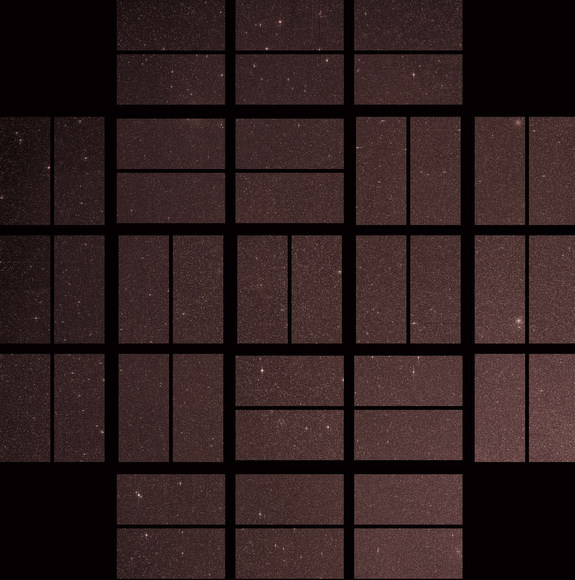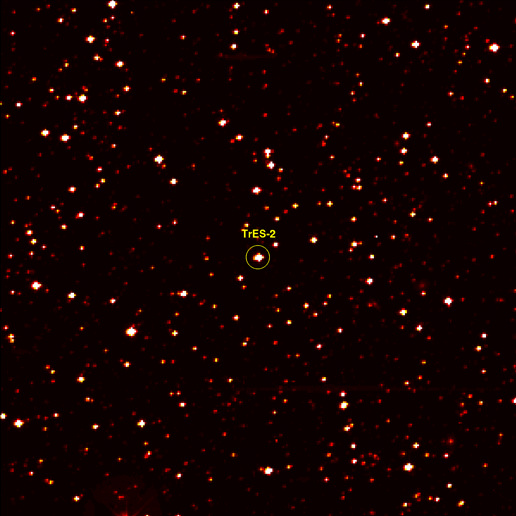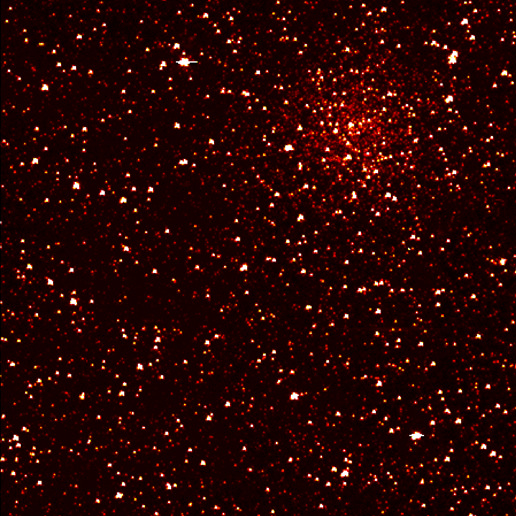[/caption]
W00t! Kepler has seen first light! The spacecraft has taken its first images of the star-rich sky where it will soon begin hunting for planets like Earth. These first images show the mission’s target patch of sky, a vast starry field in the Cygnus-Lyra region of our Milky Way galaxy. One image shows millions of stars in Kepler’s full field of view, while two others zoom in on portions of the larger region. “Kepler’s first glimpse of the sky is awe-inspiring,” said Lia LaPiana, Kepler’s program executive at NASA Headquarters in Washington. “To be able to see millions of stars in a single snapshot is simply breathtaking.”
The image above zooms into a small portion — just 0.2 percent –of Kepler’s full field of view, and shows an an expansive, 100-square-degree patch of sky in our Milky Way galaxy, and a cluster of stars located about 13,000 light-years from Earth, called NGC 6791, can be seen in the upper right corner. These images were taken on April 8, 2009, one day after Kepler’s dust cover was jettisoned. See more below.

This image shows Kepler’s entire field of view — a 100-square-degree portion of the sky, equivalent to two side-by-side dips of the Big Dipper. The regions contain an estimated 14 million stars, more than 100,000 of which were selected as ideal candidates for planet hunting. “It’s thrilling to see this treasure trove of stars,” said William Borucki, science principal investigator for Kepler at NASA’s Ames Research Center at Moffett Field, Calif. “We expect to find hundreds of planets circling those stars, and for the first time, we can look for Earth-size planets in the habitable zones around other stars like the sun.”
Kepler will spend the next three-and-a-half years searching more than 100,000 pre-selected stars for signs of planets. It is expected to find a variety of worlds, from large, gaseous ones, to rocky ones as small as Earth. The mission is the first with the ability to find planets like ours — small, rocky planets orbiting sun-like stars in the habitable zone, where temperatures are right for possible lakes and oceans of water.

This image zooms in on a region containing a star, called Tres-2, with a known Jupiter-like planet orbiting every 2.5 days.
To find the planets, Kepler will stare at one large expanse of sky for the duration of its lifetime, looking for periodic dips in starlight that occur as planets circle in front of their stars and partially block the light. Its 95-megapixel camera, the largest ever launched into space, can detect tiny changes in a star’s brightness of only 20 parts per million. Images from the camera are intentionally blurred to minimize the number of bright stars that saturate the detectors. While some of the slightly saturated stars are candidates for planet searches, heavily saturated stars are not.
“Everything about Kepler has been optimized to find Earth-size planets,” said James Fanson, Kepler’s project manager at NASA’s Jet Propulsion Laboratory in Pasadena, Calif. “Our images are road maps that will allow us, in a few years, to point to a star and say a world like ours is there.”
Scientists and engineers will spend the next few weeks calibrating Kepler’s science instrument, the photometer, and adjusting the telescope’s alignment to achieve the best focus. Once these steps are complete, the planet hunt will begin.
“We’ve spent years designing this mission, so actually being able to see through its eyes is tremendously exciting,” said Eric Bachtell, the lead Kepler systems engineer at Ball Aerospace & Technology Corp. in Boulder, Colo. Bachtell has been working on the design, development and testing of Kepler for nine years.
Source: NASA


In the spirit of Dr. Flimmer, I would like to note that Kepler did not believe in gravitation.
Kepler correctly believed that orbital intertia is electromagnetic in origin.
“The example of the magnet I have hit upon is a very pretty one, and entirely suited to the subject; indeed, it is little short of being the very truth.” — Johannes Kepler, astronomer/mathematician, 1609
“It is therefore plausible, since the Earth moves the moon through its species and magnetic body, while the sun moves the planets similarly through an emitted species, that the sun is likewise a magnetic body.” — Johannes Kepler, astronomer/mathematician, 1609
“But come: let us follow more closely the tracks of this similarity of the planetary reciprocation [libration] to the motion of a magnet, and that by a most beautiful geometric demonstration, so that it might appear that a magnet has such a motion as that which we perceive in the planet.” — Johannes Kepler, astronomer/mathematician, 1609
Inertia rather…:P
how is kepler different from other telescopes?
I thought it used the same techniques as any other just alot better but it says here that they’ll be able to detect what zone there in, in comparison to there own sun. Now that has to be some thing else. You cant do that with the wobble method . Could you?
As I understand it, Kepler isn’t using the “wobble method”. It’s looking for the change in brightness caused by planets passing in front of stars.
And since it’s looking for changes over many months, it can detect planets that are farther away from the star. (The farther away the planet, the longer the orbital period).
Presumably, a planet with an orbital period of many months or a few years might be in the “habitable zone” of a star like our sun.
Most planets detected so far by earth-based telescopes are quite close to the star, so they have orbital periods of days or weeks, not months or years. These planets are too hot for life (as we know it).
Yes! It is breathtaking indeed. Magnificent!
Breathtaking! Magnificent! Awesome!
Let the SCIENCE begin!
Only a couple years before the first earth-like planet will be discovered. I must admit I’m giddy at the thought of it.
Nice one, am expecting great things from this telescope.
I hope there is a very fast orbitting planet around a small sun that does not take years to confirm. :-p
Beautiful. I can just imagine those seemingly tiny stars in its field of view, blinking away ever so softly as they have done for millions of years, with Kepler carefully collecting the bounty of data. Planets await discovery! And of course the Cephieds, pulsing away and giving up their secrets almost begging to be understood.
The data from this mission will be exciting indeed.
@OilIsMastery strikes again… I love your posts… What does your post have to do with the Kepler observatory? And exactly how is inertia related to an electromagnetic field??? So you are implying General Relativity is incorrect?
imode Says:
April 16th, 2009 at 8:08 pm
Don’t worry too much imode – Oils posts have little to do with anything most of the time… that GR is incorrect and an EM field can somehow induce inertia in massive objects is among the least whack of Oils’ ideas. He’s invented his own physics, but done away with pesky hindrances like quantitative prediction and striving for agreement with the set of all known observations. This removes the problems and difficulties inherent in having a falsifiable theory and hence it must be correct! All that is required is a little faith, a willingness to suppress doubt and a complete rejection of any work done in science in the last 200 years…
I think that’s how the logic goes anyway.
I’ve been staring at the image for some time now. I’m so overawed I can’t express what I feel. I’m beginning to realize that if there is someone else on a planet in orbit around one of those stars who is looking at a similar patch of sky, that they will be looking at their patch of sky which contains millions of stars and one of them is our sun, us. That person is thinking of me, and I’m thinking of that person. To that person I say “Hello”.
It will certainly whet the appetite for space exploration as we find our first “Earth”, then dozens, hundreds and thousands more.
Astrofiend:
LOGIC? Oils?
At least you didn’t use them IN THEM SAME SENTENCE, LOL! 😉
This is great news!
I have long complained that NASA needs to focus more time and effort on Earth’s heat source – the Sun – but this is definitely one of the better of the other projects.
The universe is so vast and we know so little!
With kind regards,
Oliver K. Manuel
http://myprofile.cos.com/manuelo09
Can anyone explain about the ‘intentional blurring’ of the image to prevent saturation? I don’t understand how blurring the image means less light. Also, the individual star that is labelled looks quite saturated. I am a bit confused!
Yes, Oils does not beleive in Gravity. He beleives in EM. EM is everything to him. When I knock a pencil off my desk (which is actually a table right now, as we’re moving our offices from up here at Keystone to downtown at Capital Center… I hear the parking situation is much better nowadays than when I worked downtown in the early 90s) it hits the floor due to EM effects.
Never mind that when we launch a craft into space, we use gravitational equations and hit the target every single time.
Wow.
Its Full of Stars
BeckyWS, About the blurring: It means less light per pixel as instead of a bright point light you see a dimmer disc light as it is dispersed across several pixels.
And about the saturated looking star from the second image: Nasa’s Kepler site says that: “The image has been color-coded so that brighter stars appear white, and fainter stars, red.”
It is impressive how UT seems to have the
notable astronimical stories before
anyone else –
good on ya FC
It is impressive how UT seems to have the
important astronomical stories before anyone else –
good on ya Fraser
It is impressive how UT seems to carry the important
astronomical stories before anyone else –
good on ya Fraser and Nancy
JX
Dontcha wish you could edit you posts after putting them up?
😀
Imode,
Do you know who Kepler is?
As I said in my post, Kepler did not believe in gravitation. He said orbital inertia is electromagnetic. In the future please read the quotes so you can comment intelligently.
Astrofiend,
“GR is incorrect”
Obviously: http://www3.interscience.wiley.com/journal/114107477/abstract?CRETRY=1&SRETRY=0
“an EM field can somehow induce inertia in massive objects is among the least whack of Oils’ ideas.”
What causes inertia if not electromagnetism?
“What we call mass would seem to be nothing but an appearance, and all inertia to be of electromagnetic origin.” — Henri Poincaré, physicist, 1908
“He’s invented his own physics”
I haven’t invented anything but thank you for crediting me with the work of the geniuses I quote.
You guys, is so simple. Gravity isn’t real. Everything is simply expanding.
When a pencil falls off a table, it’s actually stationary. The Earth is simply expanding to fill in the space. Because we are expaning along with the Earth, we percieve the pencil as “falling”.
I think that’s how the theory (or one of them) goes. I’m not sure how orbits are explained, though. 🙂
Dark Gnat,
That’s a lot closer to the truth than Newton, Laplace, and Einstein ever were.
If the pencil didn’t fall, whats that thing on the floor that looks like the pencil that was on my desk??
Jeri,
If the pencil didn’t fall, it’s being held up by electrons.
If it did fall, it’s probably being pushed by electrons.
Jari- thanks for that explanation.
Oils:
“What causes inertia if not electromagnetism?”
Well by telekinesis of invisible aliens trapped in area 51 of course, what else?
Oils:
“If it did fall, it’s probably being pushed by electrons.”
Come on Oils, you don’t even understand your own EU theorie?
Acording your EU theory electrons consist of subtrons, internal structure inside the electron that NO ONE HAS EVER CONFIRMED SO FAR. Magnetic field will squash the subtronic orbits making the electron elongated so one side becomes positive static field and the other side negative static field! aka “electrostatic
dipoles” Basically you could look at this as small magnets attracting each other.
You see, EU believe that electrons are tiny magnets that attract each other caused by the magnetic fields and that explains gravity. But Oils fail in understanding this since he believes that the electorns pushs!
And here comes the clue, where does this magnetic field come that squashes the internal orbits of the subtrons? Well of course by electricity, since moving electrons causes magnetic fields.
Now since you need a magnetic field, you need moving electrons thus electricity to squash the subtrons to these elongated electrons that becomes these static dipoles that will align themselves aka magnets causing gravity.
So accorrding to EU theory you could prove this gravity by just sticking a voltage meter in the ground and measure the electricity going through the ground. Also in a metal hollow ball any object inside will float since a cage of varraday will not gave any magnetic field inside the cage itself! And next to a MRI scanner that creates the biggest magnetic field in the world, things that are none-magnetic should start to float! Also luckily that we point our magnets horizontal since if we orient them vertially they will point to the heaven! And also EU predicts that people at the equator will float since the birkley currents arrive at the poles so and moves through the earth to the other side so all our water in the sea are attracted to the polar regions.
Believe me, if you look at the EU theory and if you look at the theory of aliens stuck in Area 51 using telekinesis to create gravity, the aliens makes more sense to me? LOL
Olaf,
“Well by telekinesis of invisible aliens trapped in area 51 of course, what else?”
That makes more sense than gravitation.
“Acording your EU theory”
You don’t know my theory.
“electrons consist of subtrons, internal structure inside the electron that NO ONE HAS EVER CONFIRMED SO FAR.”
YOU MEAN LIKE GRAVITONS?
OilIsMastery Says:
“Olaf,
“Well by telekinesis of invisible aliens trapped in area 51 of course, what else?”
That makes more sense than gravitation.”
Of course, we have independent proof that roswell did happen, that Area 51 does hold aliens and telekinesis actually exist! We even have footage of russian scientist experimenting with telekinesis and footage of real ufo’s.
This is far more evidence than the EU has about it’s theory!
Gavitons are overrated, Telekinesis by aliens, that is someing very cool someone can believe in.
Now, that’s amazing, not some shitty shadows on Jupiter.
Oill, get the f*ck outta here.
Wouldn’t it be nice to build a time machine and send Oils back to the 17th century where he could converse directly with Kepler, Tycho, Flamsteed, Leibnitz, Newton and all his other friends. And think of the benefits to UT readers, he’ll have no internet access! Sounds like a win-win situation.
Jon Hanford,
NIMT (Not In My Timeline)!
Let’s hope that it’s an alternate timeline because we don’t know what this guy is capable of. I’m sure hillarity will ensue if Oils meets up with these guys but you don’t know what the timeline consequences would be.
@ND, You might just have a point. If he converted Newton from a ‘creationist’ to a fundamentalist, we’d have a a whole new ‘theology of gravitation’.
Kepler is simply awesome. What possibilities for mankind!
I think that Oills Mastery was born in the Summer of Love in Haight-Ashbury and that Timothy Leary was his dad.
HeadAroundU Says:
April 17th, 2009 at 5:08 pm
>Gotta love the direct approach!